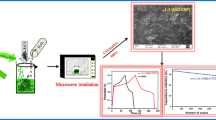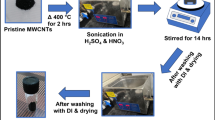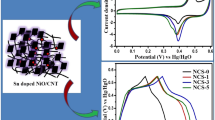Abstract
The fabrication and testing of new materials for energy storage applications is slowly gaining impetus amidst the constantly developing technological sector. Carbon-based materials have been extensively used for their high surface area, conductivity and good mechanical properties. Here, acid functionalized carbon nanotubes and its ZnO composite have been prepared using a facile microwave assisted technique and their electrochemical performances have been compared. The samples have been characterised using spectral techniques such as UV–Visible, FTIR and Raman spectroscopy. Their surface morphology has been studied using Scanning electron microscopy. X-ray diffraction analysis has been performed on the samples to further characterise the synthesised nanomaterials. Their electrochemical properties were investigated using cyclic voltammetry, chronopotentiometry and AC impedance techniques. The samples exhibit enhanced specific capacitance and good cycling stability. A high value of specific capacitance was achieved for CNT-COOH/ZnO thereby reinforcing the improvement of electrochemical characteristics of acid functionalized carbon nanotubes through composite formation.
Graphic abstract
















Similar content being viewed by others
References
Kim BK, Sy S, Yu A, Zhang J (2015) Electrochemical supercapacitors for energy storage and conversion. Handb Clean Energy Syst. https://doi.org/10.1002/9781118991978.hces112
Yassine M, Fabris D (2017) Performance of commercially available supercapacitors. Energies. https://doi.org/10.3390/en10091340
Raza W, Ali F, Raza N et al (2018) Recent advancements in supercapacitor technology. Nano Energy 52:441–473. https://doi.org/10.1016/j.nanoen.2018.08.013
Gautham Prasad G, Shetty N, Thakur S et al (2019) Supercapacitor technology and its applications: a review. IOP Conf Ser Mater Sci Eng. https://doi.org/10.1088/1757-899X/561/1/012105
Miguel M, Nogueira T, Martins F (2017) Energy storage for renewable energy integration: the case of Madeira Island, Portugal. Energy Procedia 136:251–257. https://doi.org/10.1016/j.egypro.2017.10.277
Fisher RA, Watt MR, Jud Ready W (2013) Functionalized carbon nanotube supercapacitor electrodes: a review on pseudocapacitive materials. ECS J Solid State Sci Technol 2:M3170–M3177. https://doi.org/10.1149/2.017310jss
Demming A (2016) Supercapacitors empower sustainable energy storage. Nanotechnology. https://doi.org/10.1088/0957-4484/27/25/250201
Bakker MG, Frazier RM, Burkett S et al (2012) Perspectives on supercapacitors, pseudocapacitors and batteries. Nanomater Energy 1:136–158. https://doi.org/10.1680/nme.11.00007
Zhang Y, Feng H, Wu X et al (2009) Progress of electrochemical capacitor electrode materials: a review. Int J Hydrogen Energy 34:4889–4899. https://doi.org/10.1016/j.ijhydene.2009.04.005
Zhang Y, Mei H, Cao Y et al (2021) Recent advances and challenges of electrode materials for flexible supercapacitors. Coord Chem Rev 438:21390. https://doi.org/10.1016/j.ijhydene.2009.04.005
Kiamahalleh MV, Zein SHS, Najafpour G et al (2012) Multiwalled carbon nanotubes based nanocomposites for supercapacitors: a review of electrode materials. Nano. https://doi.org/10.1142/S1793292012300022
Conway BE (1999) Electrochemical supercapacitors scientific fundamentals and technological applications
Kamran U, Heo YJ, Lee JW, Park SJ (2019) Functionalized carbon materials for electronic devices: a review. Micromachines. https://doi.org/10.3390/mi10040234
Pan H, Li J, Feng YP (2010) Carbon nanotubes for supercapacitor. Nanoscale Res Lett 5:654–668. https://doi.org/10.1007/s11671-009-9508-2
Choi H, Yoon H (2015) Nanostructured electrode materials for electrochemical capacitor applications. Nanomaterials 5:906–936. https://doi.org/10.3390/nano5020906
Gul H, Shah AUHA, Krewer U, Bilal S (2020) Study on direct synthesis of energy efficient multifunctional polyaniline–graphene oxide nanocomposite and its application in aqueous symmetric supercapacitor devices. Nanomaterials. https://doi.org/10.3390/nano10010118
Pelinovskaya N, Bottero J, Masion A (2012) Encyclopedia of nanotechnology
Sasirekha C, Arumugam S, Muralidharan G (2018) Green synthesis of ZnO/carbon (ZnO/C) as an electrode material for symmetric supercapacitor devices. Appl Surf Sci 449:521–527. https://doi.org/10.1016/j.apsusc.2018.01.172
Simon R, Chakraborty S, Konikkara N, Mary NL (2020) Functionalized polystyrene maleic anhydride copolymer/ZnO nanocomposites for enhanced electrochemical performance. J Appl Polym Sci. https://doi.org/10.1002/app.48945
Chakraborty S, M AR, Mary NL, (2020) Biocompatible supercapacitor electrodes using green synthesised ZnO/Polymer nanocomposites for efficient energy storage applications. J Energy Storage. https://doi.org/10.1016/j.est.2020.101275
Li Y, Huang X, Zeng L et al (2019) A review of the electrical and mechanical properties of carbon nanofiller-reinforced polymer composites. J Mater Sci 54:1036–1076. https://doi.org/10.1007/s10853-018-3006-9
Flahaut E, Peigney A, Laurent C et al (2000) Carbon nanotube-metal-oxide nanocomposites: microstructure, electrical conductivity and mechanical properties. Acta Mater 48:3803–3812. https://doi.org/10.1016/S1359-6454(00)00147-6
Zhang Y, Chang C, rong, Jia X dong, et al (2020) Morphology-dependent NiMoO4/carbon composites for high performance supercapacitors. Inorg Chem Commun. https://doi.org/10.1016/j.inoche.2019.107631
Zhang Y, Chang C, rong, Jia X dong, et al (2020) Influence of metallic oxide on the morphology and enhanced supercapacitive performance of NiMoO4 electrode material. Inorg Chem Commun. https://doi.org/10.1016/j.inoche.2019.107697
Zhang Y, Mei HX, Gao HL et al (2020) Metal oxide modified (NH4) (Ni, Co)PO4·067H2O composite as high-performance electrode materials for supercapacitors. Inorg Chem Commun 112:107696
Sadegh H, Shahryari-Ghoshekandi R, Agarwal S et al (2015) Microwave-assisted removal of malachite green by carboxylate functionalized multi-walled carbon nanotubes: kinetics and equilibrium study. J Mol Liq 206:151–158. https://doi.org/10.1016/j.molliq.2015.02.007
Khan J, Ilyas S, Akram B et al (2018) Zno/NiO coated multi-walled carbon nanotubes for textile dyes degradation. Arab J Chem 11:880–896. https://doi.org/10.1016/j.arabjc.2017.12.020
Chakraborty S, Mary NL (2020) A carbon nanotube reinforced functionalized styrene-maleic anhydride copolymer as an advanced electrode material for efficient energy storage applications. New J Chem 44:4406–4416. https://doi.org/10.1039/c9nj05978d
Chakraborty S, Farida JJ, Simon R et al (2020) Averrhoe carrambola fruit extract assisted green synthesis of zno nanoparticles for the photodegradation of congo red dye. Surf Interfaces 19:100488. https://doi.org/10.1016/j.surfin.2020.100488
Abdullah OG, Aziz SB, Omer KM, Salih YM (2015) Reducing the optical band gap of polyvinyl alcohol (PVA) based nanocomposite. J Mater Sci Mater Electron 26:5303–5309. https://doi.org/10.1007/s10854-015-3067-3
Mishra SK, Tripathi SN, Choudhary V, Gupta BD (2015) Surface plasmon resonance-based fiber optic methane gas sensor utilizing graphene-carbon nanotubes-poly (Methyl Methacrylate) hybrid nanocomposite. Plasmonics 10:1147–1157. https://doi.org/10.1007/s11468-015-9914-5
Chen CS, Chen XH, Yi B et al (2006) Zinc oxide nanoparticle decorated multi-walled carbon nanotubes and their optical properties. Acta Mater 54:5401–5407. https://doi.org/10.1016/j.actamat.2006.07.003
Malikov EY, Muradov MB, Akperov OH et al (2014) Synthesis and characterization of polyvinyl alcohol based multiwalled carbon nanotu be nanocomposites. Phys E Low Dimens Syst Nanostruct 61:129–134. https://doi.org/10.1016/j.physe.2014.03.026
Hong RY, Qian JZ, Cao JX (2006) Synthesis and characterization of PMMA grafted ZnO nanoparticles. Powder Technol 163:160–168. https://doi.org/10.1016/j.powtec.2006.01.015
de Menezes BRC, Ferreira FV, Silva BC et al (2018) Effects of octadecylamine functionalization of carbon nanotubes on dispersion, polarity, and mechanical properties of CNT/HDPE nanocomposites. J Mater Sci 53:14311–14327. https://doi.org/10.1007/s10853-018-2627-3
Silambarasan M, Saravanan S, Soga T (2015) Raman and photoluminescence studies of Ag and Fe-doped ZnO nanoparticles. Int J ChemTech Res 7:1644–1650
Jyothibasu JP, Chen MZ, Lee RH (2020) Polypyrrole/Carbon nanotube freestanding electrode with excellent electrochemical properties for high-performance all-solid-state supercapacitors. ACS Omega. https://doi.org/10.1021/acsomega.9b04029
Takassi MA, Zadehnazari A (2017) Green synthesis of salicylic acid-based poly (amide-imide) in ionic liquid and composite formation with multiwalled carbon nanotube. Polym Plast Technol Eng 56:1358–1365. https://doi.org/10.1080/03602559.2016.1275686
Tahermansouri H, Dehghan Z, Kiani F (2015) Phenol adsorption from aqueous solutions by functionalized multiwalled carbon nanotubes with a pyrazoline derivative in the presence of ultrasound. RSC Adv 5:44263–44273. https://doi.org/10.1039/c5ra02800k
Birch ME, Ruda-Eberenz TA, Chai M et al (2013) Properties that influence the specific surface areas of carbon nanotubes and nanofibers. Ann Occup Hyg 57:1148–1166. https://doi.org/10.1093/annhyg/met042
Norzilah AH, FakhruL-Razi A, Choong TSY, Chuah AL (2011) Surface modification effects on CNTs adsorption of methylene blue and phenol. J Nanomater. https://doi.org/10.1155/2011/495676
Chen Y, Liu C, Li F, Cheng HM (2006) Pore structures of multi-walled carbon nanotubes activated by air, CO2 and KOH. J Porous Mater 13:141–146. https://doi.org/10.1007/s10934-006-7017-6
Septiani NLW, Yuliarto B, Nugraha, Dipojono HK (2017) Multiwalled carbon nanotubes–zinc oxide nanocomposites as low temperature toluene gas sensor. Appl Phys A Mater Sci Process 123:0. https://doi.org/10.1007/s00339-017-0803-y
Zhang M, Li Q, Fang D et al (2015) NiO hierarchical hollow nanofibers as high-performance supercapacitor electrodes. RSC Adv 5:96205–96212. https://doi.org/10.1039/c5ra17011g
Wang G, Liang R, Liu L, Zhong B (2014) Improving the specific capacitance of carbon nanotubes-based supercapacitors by combining introducing functional groups on carbon nanotubes with using redox-active electrolyte. Electrochim Acta 115:183–188. https://doi.org/10.1016/j.electacta.2013.10.165
Inamuddin SN, Imran Ahamed M et al (2020) Green synthesis of ZnO nanoparticles decorated on polyindole functionalized-MCNTs and used as anode material for enzymatic biofuel cell applications. Sci Rep 10:1–10. https://doi.org/10.1038/s41598-020-61831-4
Balakrishna Pillai P, Kumar A, Song X, De Souza MM (2018) Diffusion-controlled faradaic charge storage in high-performance solid electrolyte-gated zinc oxide thin-film transistors. ACS Appl Mater Interfaces 10:9782–9791. https://doi.org/10.1021/acsami.7b14768
Song X, Chen Q, Shen E, Liu H (2020) N-Doped 3D hierarchical carbon from resorcinol-formaldehyde-melamine resin for high-performance supercapacitors. New J Chem 44:8638–8649. https://doi.org/10.1039/c9nj06415j
Mohan U, Gogoi P, Baruah SK (2017) Mixed ionic and electronic conductivity study of charge transfer complexes of some substituted pyridines with iodine monochloride (ICl) by AC impedance spectroscopy. Ionics 23:157–168. https://doi.org/10.1007/s11581-016-1794-y
Sivaraman P, Mishra SP, Potphode DD et al (2015) A supercapacitor based on longitudinal unzipping of multi-walled carbon nanotubes for high temperature application. RSC Adv 5:83546–83557. https://doi.org/10.1039/c5ra13136g
Kampouris DK, Ji X, Randviir EP, Banks CE (2015) A new approach for the improved interpretation of capacitance measurements for materials utilised in energy storage. RSC Adv 5:12782–12791. https://doi.org/10.1039/c4ra17132b
Acknowledgements
We would like to thank the DST-FIST programme-2015 LEVEL 0 for providing us with the instrumentation facilities to carry out this research work. We are grateful to the Centre for Research in Science and Technology (CRIST), Stella Maris College, Chennai for helping us with the characterisation of the samples.
Author information
Authors and Affiliations
Corresponding author
Ethics declarations
Conflict of interest
The authors declare that they have conflict of interest.
Additional information
Publisher’s Note
Springer Nature remains neutral with regard to jurisdictional claims in published maps and institutional affiliations.
Rights and permissions
About this article
Cite this article
Chakraborty, S., Simon, R., Antonia Trisha Zac, R. et al. Microwave-assisted synthesis of ZnO decorated acid functionalized carbon nanotubes with improved specific capacitance. J Appl Electrochem 52, 103–114 (2022). https://doi.org/10.1007/s10800-021-01621-6
Received:
Accepted:
Published:
Issue Date:
DOI: https://doi.org/10.1007/s10800-021-01621-6




